CW: Baby loss, death, death of a baby, bereavement, child bereavement
FINE. I’ll burn another bridge.
Every time I make a post like this, I am acutely aware that doing so tends to further deteriorate my chances of gainful work opportunities, but I’ve reached a resigned, defeatist stage in life where I’d rather keep shooting myself in the foot until I die than continue to live and play along with LinkedIn levels of toxic positivity and good-looking-but-hardly-meaningful posturing to make brands look good, but beyond that sell little more than illusions, branded merch, and brief moments of warm fuzzy feelings. It’s exploitative of and not really helpful to the causes involved or the people affected.
Don’t get me wrong: Corporate clout chasing works. That’s why brands do it. But just because something works, doesn’t mean you should use it at every given opportunity with the least amount of effort. Put in the work!
The trigger for today’s long piece is this LinkedIn post:
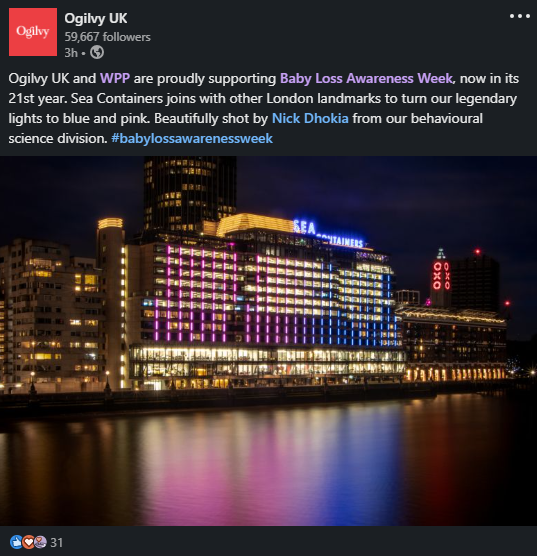
At the time of me hitting the publish button on this Substack post, the public reactions to Ogilvy’s LinkedIn post that trigged it (pictured above) is unequivocally positive. My personal feelings about it are… not.
Let me be very clear upfront: My main criticism is not with Baby Loss Awareness Week or with Baby Loss Awareness Week Alliance, both of which I strongly support. These initiatives can be of immense value, by way of support to anyone who has ever experienced baby loss. Their work at the very least acknowledges and validates people bereaved by the death of a baby and helps commemorate the babies they lost. Their list of resources for those affected by baby loss is extensive. If I have to level any criticism at the Baby Loss Awareness Alliance at all, it’s that, in a way, they may have (inadvertently?) contributed to a LinkedIn post like the one pictured above—more about that later.
Individual people are (mostly) powerless. They are not at fault when all they can do is provide a listening ear, be a shoulder to cry on, wear a commemorative pin or light a candle in church or at home to express that their fellow human beings (and the babies they lost) are in their thoughts. If I had to level any criticism at individuals at all it’s that, well, there is plenty, but all that’s a post for another day and tiny pickings compared to corporate or celebrity brands with sizeable influence.
My criticism here is reserved for Ogilvy and WPP. And it’s personal.
Baby Loss Awareness Week
This week, from 9 to 15 October 2023, is Baby Loss Awareness Week. Baby Loss Awareness Week returns each year, to focus attention at people affected by baby loss (including but not limited to ectopic pregnancy, miscarriage, and stillbirth) and their stories, while commemorating the babies they lost. It’s also a week to raise awareness among the greater public that, sadly, many people are affected by the death of a baby and that, if we take the time to pay mind to them and their stories, perhaps we can work together to become a more sensitive, caring and supportive society towards those affected.
Every person affected by baby loss is different, thus everyone experiencing baby loss is likely to be affected and responding differently. Therefore I can only tell you my own story here. I do not wish to speak for others and my experiences here should not in any way be used to invalidate other people’s.
My own miscarriage happened in May 2004 following an ectopic pregnancy. It unleashed or uncovered (possibly both) physical health issues that could be debilitating and would take another eleven and a half years of hospitalisations, surgeries, treatments and therapies to relieve and resolve to the point that I am now mostly symptom free. My last surgery, the final liberation from over 11 years of chronic illness and pain, didn’t just ‘fix’ my body; it did more for my mental and emotional health than any self-help book, patient support group or talking therapy had been able to do. So today, over nineteen years after my miscarriage and eight years after my last surgery, it’s no longer difficult to talk about my pregnancy and miscarriage. But the grief I continue to feel means I still find myself triggered by social media posts like the one pictured above. And especially when it concerns posts made on behalf of brands I expect better from.
Baby Loss Awareness Week provides me with an opportunity to share both my positive and negative experiences after my miscarriage. Both are important for me to share, because I feel that they can potentially help individuals and organisations in deciding what they can do for people affected by baby loss.
In the immediate aftermath of my miscarriage, I received mostly compassion and support. The person who said “Welp, saves you another mouth to feed!” did not have malicious intent but their words stung. “I know exactly how you feel!” triggers me to this day because in the struggle of making sense of what had happened, I often barely knew how I felt. The person who initially responded “Miscarriage? That’s just like an upset stomach, right?” later apologised. (Someone else had explained to them how insensitive that had been—a moment of personal growth.) I am grateful to those employers and clients who paid partial or full wages during some of my hospital stays. I am grateful to those workplaces that enabled or even encouraged flexible working hours and remote/hybrid working arrangements so I could work around my symptoms, my treatments, my meds and my hospitalisations. To this day I will occasionally cry with sadness that I forgot the name of the (American? Canadian?) colleague who I still shed tears of gratitude over for bringing flowers to my desk and hugging me, saying “I am glad to have you back!” on my return to the office after one of my hospital stays.
Good intentions
I am trying to be kind about this LinkedIn post. I am assuming that Ogilvy’s intent wasn’t disingenuous or an attempt at flippant commodification of a serious theme to make their brands look good. That it was done with the best of intentions. And it did not trigger me in the sense that I feel any negative impact from it, but in the sense of… I feel there was a lot – too much – that was missing from it.
Style
I am not against pink and blue lights or decorations. My issue here is, that from large organisations, particularly influential communications, PR, marketing and advertising giants such as Ogilvy and their parent company WPP, I expect more and better than the equivalent of
“We support [this cause]. Here’s a picture of a landmark building lit up in [the colours of this cause], made by [colleague] in [team/department].”
The very least I would expect from them would be something like
“We have partnered with [cause]. Here’s everything we’re doing: <link>. To mark [occasion] and [honour/commemorate] [cause/group], [landmark] [was/is/will be] lit up in [the colours of this cause] on [date/time]. Photograph courtesy of [colleague] in [team/department].”
Because then you’ve still got the (instagramable) visual attraction of a lit-up landmark and the easy click-to-like-ability of a snazzy social media post, but now you’re showing you’re serious and active beyond a mere easy-to-like social media post.
Substance
- From solely a social media perspective, style is enough and that’s what’s represented in the pictured LinkedIn post.
- From solely a social media perspective, why would anyone include a link to a web page with more substance, when few people are actually going to click on it and even fewer people are likely to read or care? Not to mention that you’re going to have to think up a creative workaround if you want to replicate the post on Instagram which doesn’t allow links in posts.
- From a purely a social media perspective, why would anyone put in that effort? Simple, snazzy social media posts, lots of virtual applause by way of reposts, likes and other positive reactions: minimal effort, maximum engagement, no rage bait, positivity only, people tend to love it; pay your social media team their deserved bonuses for jobs well done, hurrah.
But that’s not my point here. There is very much a time and place for simple, short, strong, snazzy, stand-alone (social media or other) content that engages. Time permitting, I shall dedicate future posts to this, because it’s a topic that fascinates me.
My point here, specifically, is, that in this particular context, I expect corporate brands like Ogilvy/WPP, particularly considering their organisation size and the specialisms and industries they operate in, to go beyond what they’ve done here. Because even if they never intended to minimise or commodify something as serious as baby loss, that’s essentially what they (inadvertently?) ended up doing. And most people will be fine with that (”It’s not that deep!”) but… I am not.
Depth
Again, I am not against pink and blue lights or decorations. Light up those landmarks to mark Baby Loss Awareness Week. Let individual passers-by take all the pictures they want and post them to social media with the #WaveOfLight hashtag. Let them tag your brand in their post if that’s your building.
If you are a brand of Ogilvy’s (or parent WPP’s) standing, it’s great that you support Baby Loss Awareness Week 2023 and that you express that support in lights shone onto buildings and pictures of that posted to social media, but from you – especially you! – I also expect that support to come with some substance and depth. And absolutely nobody one asked me, but I am going to set out what, how, and why. (I only represent my own opinion here and I may very well stand alone on this, but that’s never stopped from venting when triggered.)
Ogilvy is a global advertising, marketing, communication and PR agency and part of WPP's global conglomerate of advertising, commerce, communication, marketing, PR and tech companies. Ogilvy does not list its number of worldwide employees on its website – Zoominfo puts the number at around 21,000, Zippia nearer 25,000 – but whatever the number is, presumably it is incorporated in the total number of worldwide employees listed on parent company WPP’s website: 115,000 people. (Numbers as checked on 12 October 2023 and presumably subject to change.)
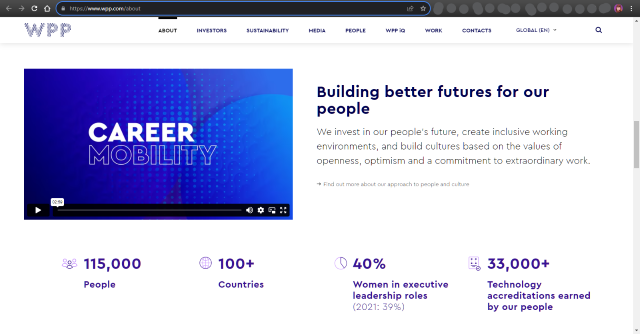
Judging by those numbers, I think it is safe to assume that Ogilvy and WPP have people in its ranks who have been affected by baby loss, as well as people whose superiors, peers, or subordinates have been affected by baby loss.
- A search of Ogilvy’s website conducted on 12 October 2023 for “baby loss awareness” returned no results.
- A search of WPP’s website conducted on 12 October 2023 for “baby loss awareness” returned no results.
- A Google search of Ogilvy’s website conducted on 12 October 2023 for “baby loss awareness” returned no results.
- A Google search of WPP’s website conducted on 12 October 2023 for “baby loss awareness” returned no results.
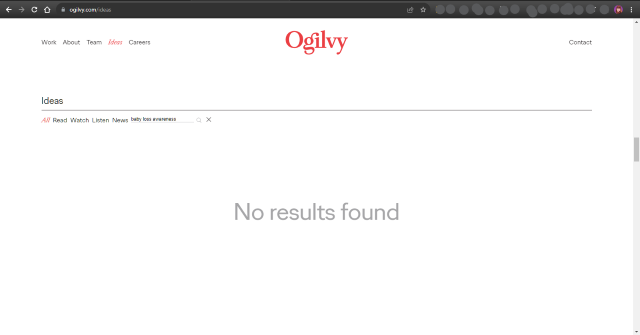
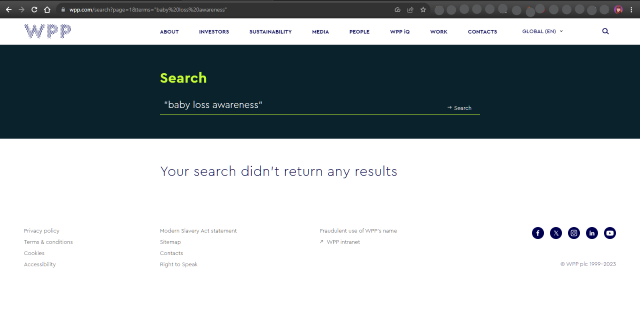
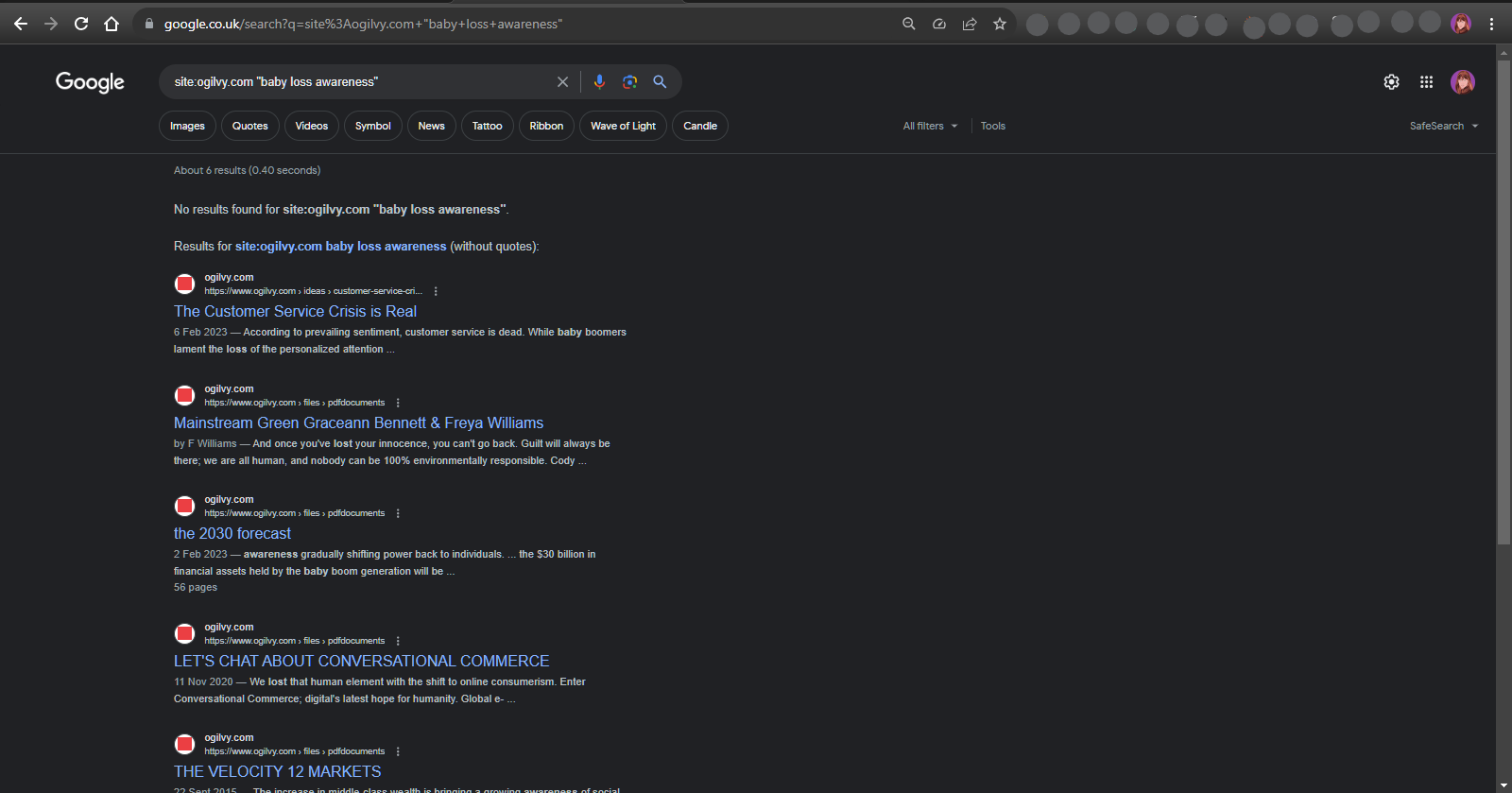
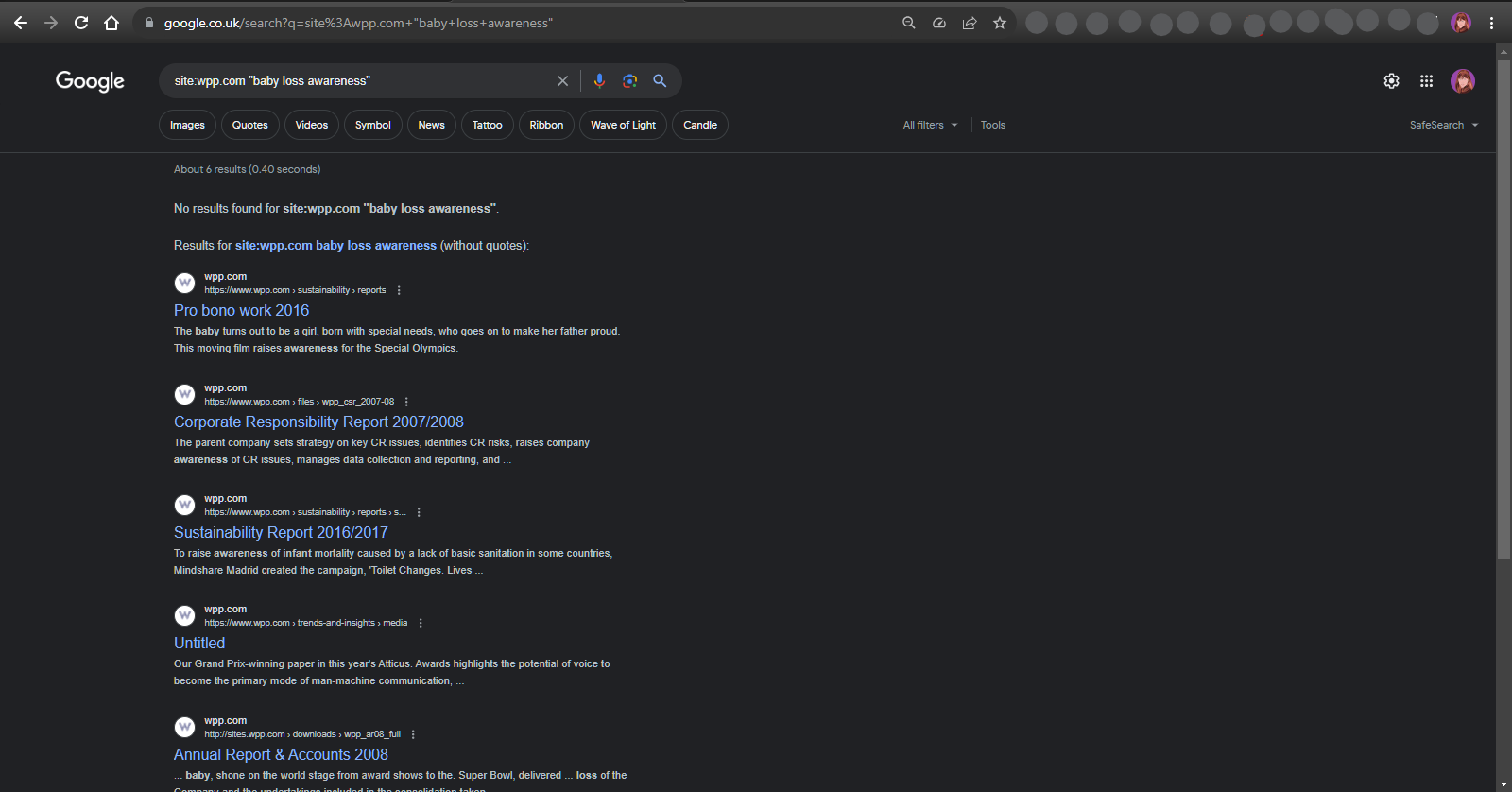
But there is, of course, that single LinkedIn post on Thursday 12 October 2023 with the picture of the pink and blue lights shone onto a building in London to mark Ogilvy’s and WPP’s support for Baby Loss Awareness Week. There just doesn’t appear to be anything else in relation to the theme.
Personally, I had hoped for more and better. I’m not angry, just disappointed.
If you’re a corporation of Ogilvy’s (or parent WPP’s) size, shining pink and blue lights onto a landmark building and posting a picture of that to social media to profess your support for Baby Loss Awareness Week 2023, that’s great! I just happen to be of the opinion that that alone is not enough.
Where on your respective websites is the press release explaining what activities you’ve been engaging in company-wide this week to mark this occasion (beyond lighting up a building in pink and blue and posting a picture of that to LinkedIn?
Any fundraising events for charities involved in supporting people affected by the death of a baby?
Any virtual or on-site coffee mornings, maybe, for people within your organisation(s) to talk about their own experiences with baby loss, to support colleagues who have had to go through similar experiences, but also to raise awareness and understanding among other colleagues?
If you hosted any events or activities this week, did anyone take pictures or create any other kind of recording?
Did participants consent to being photographed or recorded?
Have they given you permission to use these photographs and/or recordings for your intranet, social media, and for any other reporting or promotional purposes?
If they’ve given you permission to use the photographs and/or recordings, did anyone raise any specific conditions or restrictions as to the type, reach and duration of use?
Did your own or a parent/sister organisation, or any subsidiary of yours, make a corporate donation to any of the organisations that make up the Baby Loss Awareness Week Association or any other organisations that support people affected by baby loss, and if so, was it a (big cheque) photo op and tax deduction arrangement or can you elaborate on how much was donated and for which specific purposes or activities?
Have you planned any internal meetings, surveys and/or feedback sessions to assess how your organisation(s) associated and engaged with Baby Loss Awareness Week 2023?
Have you already pledged or planned any kind of involvement in Baby Loss Awareness Week 2024?
Besides and beyond Baby Loss Awareness Week, how, in your every-day operations, do you support people within your organisation(s) affected by the death of a baby?
Do you offer employees affected by baby loss paid medical or compassionate leave?
Does the ‘Careers’ section on your website(s) contain this information?
Do you provide employees affected by baby loss any kind financial or other compensation or support towards medical care or mental health care?
Does the ‘Careers’ section on your website(s) contain this information?
Do you provide employees – particularly those in positions of leadership – with any kind of guidance or training to equip them with skills to act sensitively in situations with colleagues affected by baby loss?
If you are a brand of Ogilvy’s (or parent WPP’s) size, standing, and fields of expertise I personally feel like you really missed an opportunity to do good and to do right this year. Once again: If you did what little you did with the best of intentions, the effect was a low-effort commodification of a serious subject that affects real people. (And again: I may stand alone in this opinion, but I hope if anyone’s read this far I’ve at least provided them with food for thought.)
Do more for 2024?
No one asked for my advice, but in my arrogance I am going to give some anyway.
For next year, do more. Go a bit deeper than surface-level nice or pretty. I think it might be a potentially great idea if the Baby Loss Awareness Week Association and Ogilvy/WPP (or an organisation like them) were to team up. Because it’s clear that the organisations making up the Baby Loss Awareness Week Association contain the expertise, skills and experience to support people affected by baby loss, but if their website is anything to go by, their marketing/comms game could do with some levelling up… Ogilvy and WPP harbour the talents who can help with that, and wouldn’t that be more meaningful than merely a profession of support and maybe a cheque? A partnership could benefit both the organisations involved and the cause served.
While the website for Baby Loss Awareness Week 2023 clearly states that “this Baby Loss Awareness Week we want to talk about what could be done right now to better support families affected by the death of a baby” when I browse the Baby Loss Awareness Week Association’s website for resources that could achieve that, there’s little more than “turn your office pink and blue” (pins and other merch available) and getting landmark buildings lit up in pink and blue.
I wonder if that’s what inspired Ogilvy to publish that one LinkedIn post and seemingly do little or nothing else. I wonder if that was deliberate on part of the Baby Loss Awareness Week Association, in which case I am also a tad disappointed in them.
Ogilvy and WPP could partner with Baby Loss Awarness Week and help improve and expand the resources they provide:
- There is no corporate information pack to advise organisations who want to improve how they can, for instance, organise workshops to equip employees with skills on to how sensitively and compassionately deal with colleagues affected by baby loss.
- The only supporter resources are limited merch, downloadable posters/flyers and social media graphics. This offering could be vastly expanded.
- There is no press pack for journalists and media organisations (besides some of the items mentioned above).
Further tools and resources could be developed in partnership to support efforts to increase awareness among people who are not affected by baby loss, but want to better understand and support people who are.
Finally…
The mere inclusion of serious subjects at set dates as ‘opportunities’ on a marketing or social media calendar isn’t going to “crush taboos” or “raise awareness” or [insert other popular cliché] unless backed with or accompanied by by profound actions towards effect meaningful change.
I especially hold brands to higher account, expecting them to do more than sending out virtue signals or tax-deductible donations alone. Failure to do so carries a risk of commodifying the serious subject and exploiting the real human beings affected by it.
Subscriptions to this Substack are free and I am not a paid columnist for any publication, but… you can hit the Subscribe button below to receive an email any time I post something on Substack, or you can hit the other button below to buy me a coffee, or… do both!
Further reading
Baby Loss Awareness Week: Break the silence around baby loss (2023). Retrieved from https://babyloss-awareness.org
Berthon, P.R., Lord Ferguson, S.T., Pitt, L.F., Wang, E. (2023). The virtuous brand: The perils and promises of brand virtue signalling. Retrieved from https://www.sciencedirect.com/science/article/pii/S0007681321002007
Bowers, M. (2019). The Art of Virtue Signaling: When Brands Get It Wrong. Retrieved from https://www.toptal.com/designers/brand/virtue-signaling
Lloyd, A. (2023). Fans are lashing out at Oprah Winfrey yet again after she called their criticism of her Maui fundraiser with Dwayne Johnson “vitriol.” Retrieved from https://www.insider.com/oprah-winfrey-response-fundraiser-backlash-dwayne-johnson-maui-2023-9
Lieber, C. (2018). Pinkwashing: Breast cancer awareness products profit off survivors’ suffering. Retrieved from https://www.vox.com/the-goods/2018/10/17/17989624/pinkwashing-breast-cancer-awareness-products-profit
Czepanski, D (2022). Rainbow Washing Is A Thing, Here's Why It Needs To Stop.
Retrieved from https://www.theurbanlist.com/a-list/rainbow-washing
Greenwashing: How to spot fake green claims (2022). Retrieved from https://www.greenpeace.org.uk/news/what-is-greenwashing
Triggered: Your social media post for a good cause looks great! But tell me, what do you *really* do?
About my belief that even the slightest hint at commodification of serious subjects can potentially do more harm than good for causes concerned and people affected